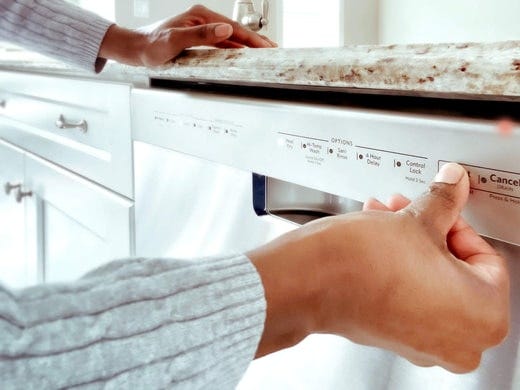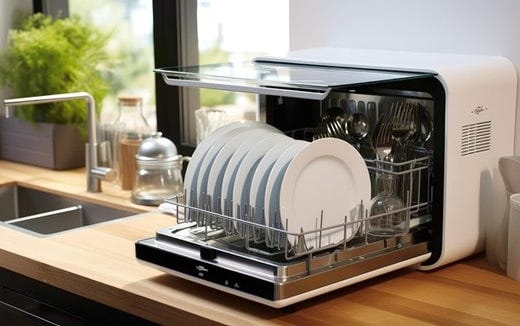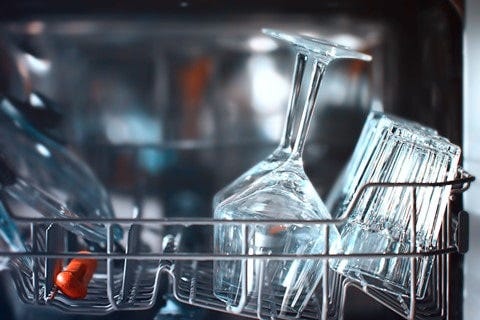
Ultimate Guide to Table Top Dishwashers
A table top dishwasher is a convenient and compact appliance. It lets you clean the dishes quickly. The tabletop dishwasher is ideal for people with limited kitchen space. Read on.

A table top dishwasher is a convenient and compact appliance. It lets you clean the dishes quickly. The tabletop dishwasher is ideal for people with limited kitchen space. Further, those residing in tiny homes or apartments where a full-size dishwasher cannot fit will also find the tabletop appliances more suitable.
Keep reading as we discuss all about tabletop dishwashers in South Africa:
- What are they?
- Their working and installation?
- How do you connect a table top dishwasher?
- Their features and benefits
- And more!
Overview
Unlike the traditional dishwashers, table top dishwashers are portable and smaller. Commonly installed on the countertop, their small size makes them the right fit for small families and individuals who do not have a giant washing load of dishes.
The tabletop dishwasher in South Africa has several settings and features that enable efficient cleaning. They may not be the same as their larger counterparts in functionality and design, but the working principles are mostly the same.
How Do They Work?
These appliances work by combining the:
- Mechanical energy
- Detergents
- Principles of Heat
Their cleaning process involves several components and steps that ensure your dishes come out squeaky clean.
- Water Intake
The appliances are attached with an inlet hose. It helps with the water supply. So, when you begin the wash cycle, the dishwasher uses the inlet to fill the water reservoir.
- Heating Element
The dishwashers have a heating element that heats the water to the desired temperature. The correct temperature helps in fool-proof cleaning. Water and heat work together to break down the residue and dirt on the dishes.
- Detergent Dispenser
The dishwasher has a small compartment that holds the detergent. After your water reaches optimal temperature, the dishwasher will emit detergent into the machine. However, it releases adequate detergent at the correct time during the cycle for efficient cleaning.
- Spray Arms
They help distribute the hot, soapy water across the dishwasher. The arms rotate during the wash cycle to ensure every dish gets cleaned well.
- Rinse Cycle
After cleaning the dishes, rinse them. In this phase:
- The appliance throws clean water onto the dishes.
- The powerful spray helps remove any residue or leftover detergent.
- You get spotless dishes, ready for use again.
- Drying Phase
After the wash cycle, you must dry the dishes. The dishes may dry by either of the following methods:
- Heating Element Method
- Fan
In the former, the heating element will heat the air inside the appliance. So, the moisture will evaporate. However, the fan blows cold air on the utensils in the latter. The air absorbs the moisture and dries the dishes. [Source: How Do Table Top Dishwashers Work?]
Features of Table Top Dishwashers
Table tops have plenty of features. Let us discuss them.
- Size
They are compact. So, they take up little space. You can fit them on a table or countertop. Hence, individuals and small households can easily accommodate them in their tiny kitchens.
- Capacity
The table tops have a capacity of two to eight place settings. Thus, they are recommended for a family of up to five.
- Settings and Programs
You will find different settings and programs in these dishwashers:
- Some models may have rapid programs for quick cleaning.
- Others may have dedicated options to clean heavily soiled dishes.
- Dishwashers may have sensors to detect the dirtiness level.
- Delay timers can be another setting on table tops to let the dishwashers begin at a convenient time.
- Self-Cleaning
Some table tops come with a self-cleaning feature. It is necessary to keep the device hygienic and free from smell. Such devices use hot water to clean the dishwasher from inside. It is a beneficial step to eliminate germs and bacteria.
- Extra Drying
In some models, you will find extra drying options. These leave your devices completely dry after washing. As part of this, the appliance uses fan-assisted drying or additional heat to eliminate excess moisture from utensils.
Table Top Dishwasher: Benefits and Advantages
Tabletops offer several benefits. These add to their popularity amongst individuals and homeowners.
Cost-Effective
Unlike most full-size dishwashers, the table tops are pocket-friendly in many ways:
- Generally, they are relatively less costly to buy.
- Since they are small, they need less detergent and other cleaning supplies.
- They are more energy efficient. So, you save on energy bills.
Space-Saving
It is one of the most prevalent benefits of table tops. Since these dishwashers are compact, they need a limited space in your kitchen. So, you can easily accommodate them.
Portable
Their compact structure also makes them portable. So, you can move around at your convenience.
Easy Installation
The table top dishwasher installation is straightforward. These appliances do not require permanent installation. Also, the table tops do not demand plumbing work.
For table top dishwasher installation:
- Connect them to the water source.
- Plug in an electric outlet.
- The appliance is ready to use.
This ease of installation makes them a better selection for people on the move.
Energy and Water-Efficient
The table tops are mostly water and energy-efficient. They are small in size. Hence, they need little energy and water to operate, making them an eco-friendly option. Further, their wash cycles are shorter. Thus, they save a lot of energy and water.
Place Settings and Capacity
As they are smaller, the table tops have a lesser capacity than full-sized machines. Usually, their place settings range between two and eight. Place settings mean the utensils are washable in a single cycle.
What place settings do you need?
- Smaller household (4-5 people): Six-place setting capacity.
- Bigger family: Eight-place setting capacity.
But capacity means more than the place settings. The shape and the size of the dishes are equally important.
For instance:
You have a dishwasher with a 6-place setting capacity. It can accommodate:
- Six bowls
- Six dinner plates
- Cutlery for six people
- Six side plates.
However, it cannot fit in larger items like pans and pots.
Typically, dishwashers have racks and silverware baskets. You can adjust them to accommodate different dish sizes. Some appliances even have fold-down tines. They let you fit larger items in the dishwasher.
Where to Place It?
When installing your table top dishwashers, the location is the primary consideration. Ideally, the dishwasher should be in a functional and convenient spot.
Near the Sink
Your dishwasher needs a water source. Thus, it helps to connect it near the sink faucet. When you place the dishwasher near the sink, it is easier to connect the intake hose to the water source.
On a Flat Surface
The surface where you install the dishwasher should be flat and stable. Ideally, placing it on tables or countertops can help. Regardless, ensure the surface is level and stable to support the weight of the dishes and the dishwasher.
Away from Heat Sources
Never keep your table top dishwashers near heat sources like stoves and ovens. They damage the dishwasher and its components. Moreover, when you install them near a heat source, they may catch fire.
In Any Convenient Location
Lastly, the location should be convenient. The dishwasher should be easy to use and access. In short, keep your dishwasher:
- Close to the sink faucet.
- On a stable and flat surface.
- Away from ovens and stoves.
- Where you have easy access.
How to Install a Table Top Dishwasher?
Step 1: Understand the Requirements
Before you start the installation, get everything handy. You will need:
- Freshwater supply to deliver water via the inlet hose.
- Power supply.
- A place to feed the waste hose out.
- Adaptor to connect the dishwasher to the kitchen faucet.
Step 2: Prep the Area
Clear the space where you wish to install the dishwasher. Ensure it is stable and levelled. Adjust the dishwasher’s feet to keep it levelled.
Step 3: Connect the Inlet Hose
Connect the hose to the faucet. However, use an adaptor if the faucet lacks a threaded outlet. Ensure the connection is secure and tight.
Step 4: Connect the Drain Hose
Connect the hose to the drain or sink, keeping the connection tight.
Step 5: Plug into the Power Outlet
But ensure:
- The outlet is grounded.
- The cord is not damaged.
Step 6: Perform a Test Cycle
Fill in the dishwasher with detergent and dishes for a test cycle. Inspect for leaks to ensure the dishwasher is functioning ok. With that, your dishwasher is installed. [Source: Tabletop Dishwasher Installation]
Table Top Dishwasher Water Requirements
Typically, these dishwashers use less water than traditional ones. Most table tops need approximately 6–8 litres of water per cycle. It is much lower than the larger machines that require at least 12-15 litres of water. Hence, using table tops amounts to savings on water bills.
Beyond their lower water requirements, the tabletop dishwashers are also energy efficient. Most models have an A+ rating. Hence, they employ less energy than traditional dishwashers. It implies saving money on energy bills while simultaneously reducing the carbon footprint.
Many tabletop dishwashers also have sensors that assess how dirty the dishes are and alter the energy and water usage accordingly. It implies that dishwashers employ less energy and water for slightly dirty dishes. Hence, the environmental impact decreases.
Draining the Dishwasher
For draining:
- Connect the outlet hose to the sink drain.
- Turn on the tap.
- The dirty water will flow out.
- Water will come off the hose into the sink.
- Empty the sink before starting the dishwasher to avoid overflow.
Cleaning and Maintenance
To keep your dishwashers working fine, you must maintain and clean them regularly.
1. Clean the Filter
The filter is the most crucial aspect of the dishwasher. It collects the debris and food particles from the water. So, clean the filter regularly. It prevents blockages and ensures smooth working.
For cleaning the filter:
- Remove it from the dishwasher.
- Wash it with warm soapy water.
- Rinse it well.
- Now replace it back.
2. Cleaning the Spray Arms
The spray arms help distribute water across the dishwasher. It is a necessary step for dishwashing. However, they become clogged over time with debris and food particles. It impacts their performance.
So, to clean the spray arms:
- Remove them from the dishwasher.
- Use a cocktail pick and remove any material from the holes.
- Rinse the arms under tap water for leftovers.
3. Load Properly
Though these dishwashers are smaller, they do have specific loading instructions. Here are some tips that can help:
- Arrange the dishes properly.
- Ensure the dishes are not overcrowded.
- Face the spray arms to ensure the best cleaning.
4. Use The Right Detergent
The correct detergent is vital for optimal cleaning performance. Some things to remember are:
- Never use a regular dishwashing soap or liquid. They can cause excessive foaming and damage the dishwasher.
- Opt for a specifically formulated detergent.
5. Use a Cleaner
It helps remove the limescale and grease from the appliance. It helps keep the dishwasher fresh.
Tip: Please read the instructions on the cleaner and run a cycle with an empty dishwasher.
6. Add Dishwasher Salt and Rinse Aid
Lastly, the rinse aid and dishwasher salt help keep the dishwasher working well. Dishwasher salt can soften the water and improve the cleaning performance.
Rinse aid helps prevent streaks and spots on the dishes. Please follow the instructions on the dishwasher for adding rinse aid and salt. [Source: Dishwasher Maintenance Tips]
Other Tips
- Keep the machine in a level position to avoid leaks.
- Never hold the dishwasher by the door when moving it.
- Wipe the gasket every few days.
- Ensure the dishwasher powder is dry.
- Use the powder in a measured quantity.
- Do not set the wrong temperature. The dishwasher needs high heat for cleaning heavily soiled dishes, but energy-saving low temperatures work for less soiled dishes.
- Avoid using heat for drying the dishes. Instead, let them air dry.
- Never expose the water lines to freezing conditions.
Top Brands
The market has several brands to choose from. Some of our top recommendations include:
Defy
- Bosch
Hisense
To Sum Up
Tabletop dishwashers offer an efficient and practical solution for small families and individuals seeking a powerful but compact appliance. Their working principles involve mechanical energy, detergents, and heat for a thorough cleaning.
With their easy installation and cost-effective nature, these are a popular choice in households. But please maintain and clean them regularly for them to last long.


